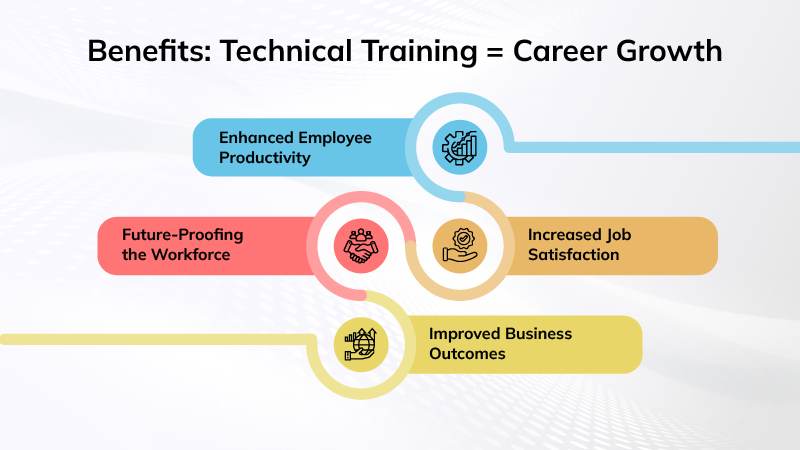What Is Technical Training? A Complete Guide for Organizations
What is technical training, and why does it matter in today’s business setting? Read this guide now to find your answers.
What is technical training, and why does it matter in today’s business setting? Read this guide now to find your answers.

The modern workplace is evolving at a pace that leaves little room for standing still. Companies that fail to keep up with the latest technologies and systems risk falling behind. That’s exactly why 57% of L&D leaders are increasing their investment in technical training.
Technical training is the process of teaching employees the practical, job-specific skills they need to perform their roles effectively. Unlike soft skills training, it focuses on tools and systems instead of communication or leadership.
If you want to learn more about how you can equip your team with these hard skills, keep reading.
Technical training helps build the practical, job-specific skills employees need to succeed in their roles. Unlike general education, technical training is highly focused and directly tied to performance in the workplace.
It’s also different from soft skills training. Soft skills focus on communication, teamwork, and leadership, while technical training equips employees with the tangible skills they need to perform their core tasks.
That also means each employee receives tailored technical training for their job. In IT, it could mean earning certifications in cloud computing or cybersecurity. In engineering, it means learning new methods or safety standards. For office-based employees, technical training is often as simple as learning a new CRM system or data analytics tool.
The recent advancements in AI, automation, and cloud computing have forced companies to rethink how they equip their teams. Employees can’t rely on outdated knowledge when the tools of their trade evolve almost yearly. With technical training, workers can stay capable, confident, and ready to meet these challenges head-on.
To support this, the WEF states that 50% of all employees will require reskilling by 2025. At the same time, 81% of organizations report struggling to find workers with the right technical abilities, which means upskilling and reskilling are urgent priorities.
Investing in technical training also pays dividends in workforce productivity and retention. Research finds that companies with comprehensive training programs see 218% higher income per employee compared to those without.
Plus, 74% of workers want ongoing learning opportunities to stay relevant and grow in their careers. Technical training allows employees to use new tech efficiently, solve complex problems, and adapt quickly to change.
Technical training doesn’t have to be delivered in a one-size-fits-all format. Different organizations and roles can benefit from different approaches, or even combine several methods to maximize results.


Investing in technical training pays off in ways that go far beyond skill development. Here are some of the many benefits that technical training can bring to your organization.
One of the most visible outcomes is increased productivity and efficiency. Employees who understand the tools and systems of their trade work faster, make smarter decisions, and contribute to smoother workflows.
Alongside this, you’ll also notice a clear reduction in mistakes. Well-trained staff make fewer costly errors, resulting in a 39% reduction in operational errors and up to 25% less downtime. That translates into stronger business continuity and fewer disruptions.
Technical training also boosts employee satisfaction and retention. A recent study found that 74% of workers actively seek new learning opportunities, and those who are offered training are 30% more likely to remain with their employer. Companies that prioritize skill development signal to employees that they are valued, which builds loyalty and reduces turnover.
Beyond internal benefits, training gives your company a competitive advantage. Businesses with highly skilled teams innovate faster, adapt to industry changes, and deliver higher-quality results.
Plus, while there is an initial investment, technical training has more cost savings in the long run. That’s because it reduces errors, downtime, and hiring expenses linked to employee turnover.

Now that you know what is technical training and how it benefits organizations, it’s time to learn how to overcome challenges that come with it. Here are some issues you might face during technical training and how to overcome them.
The first common issue is budget constraints. Training can be expensive, especially when there are certifications or advanced technology involved. As of 2023, companies spent an average of $954 per learner.
This may seem like a big number, but the long-term cost savings from fewer errors, reduced downtime, and higher retention are far higher. You can still offset costs by adopting scalable digital solutions and prioritizing the most critical skills.
Another major issue is employee resistance to change. In fact, 37% of employees resist organizational change, and 23% feel excluded from change-related decisions. Resistance usually stems from fear of the unknown, which is why clear communication and involvement in planning can go a long way.
Then, there’s the challenge of keeping up with fast-changing technology. Employees expect employers to help them stay current, and 94% say they’d stay longer at companies that invest in tech-driven learning solutions.
Modern platforms like Coursebox can make it easier to future-proof training programs. It uses AI-driven personalization to adapt learning paths to each employee’s skill level, so that training feels relevant and effective.
Plus, its hybrid and microlearning features allow employees to upskill in shorter, manageable sessions without losing productivity.
So, what is technical training? It is not just a “nice to have” investment. Since technology is evolving faster than an average company can keep up, technical training is now a necessity. It boosts productivity, lowers expenses, and reduces costly errors in the long run.
If you’re worried about employee resistance and budget constraints when implementing technical training, choose Coursebox. It’s a cost-effective and flexible learning tool that works for both employees and organizations.
Technical training is a type of structured learning program designed to improve job-specific skills such as IT, data analysis, engineering, or software use. It helps employees perform their technical roles more effectively.
Yes, technical training has many benefits for companies. It bridges skills gaps and boosts employee productivity in the long run. Plus, by reducing errors, it also helps businesses cut costs and stay competitive in rapidly changing industries.
Some common examples include IT certification courses, software training, machine operation workshops, coding bootcamps, and online technical modules.
Yes, AI-powered platforms like Coursebox are a great solution to the unique challenges that hybrid workplaces face while implementing technical training. Their AI-driven personalization and microlearning features make training more accessible and personalized.
Technical training focuses on hard, job-specific abilities like programming or operating machinery. Meanwhile, soft skills training helps teams develop interpersonal skills like communication and leadership.
They can track KPIs such as reduced error rates, improved productivity, certification completion rates, and employee feedback.
While technical training has many benefits for your organization, you may face some challenges when implementing it. The upfront investment tends to be high, and your employees may be reluctant to accept the change. However, you can easily mitigate these issues with the right learning tools and formats.
IT teams benefit the most from technical training, as their expertise relies heavily on hard skills. Other than that, industries like healthcare, manufacturing, engineering, and finance will also see a high ROI from technical training.
That depends on the industry. Ideally, it should be ongoing and personalized, but if you’re on a budget, employees should receive at least one technical training session a year to keep up with the latest advancements.
Get started for free today.
